Viewing: Blog Posts Tagged with: this is the tree, Most Recent at Top [Help]
Results 1 - 11 of 11
Blog: andrea joseph's sketchblog (Login to Add to MyJacketFlap)
JacketFlap tags: illustrator, illustration, love, inspiration, line drawing, brush pen, Joni Mitchell, Joni, things I love, AJ, illustrator for hire, andrea joseph, Pentel brush pen, Add a tag
Blog: Ice-Cream Monster Cinema (Login to Add to MyJacketFlap)
JacketFlap tags: art, painting, watercolor, Alina Chau, gouache, gallery show, Joni Mitchell, A case of you, Add a tag
Blog: wheelerwrite (Login to Add to MyJacketFlap)
JacketFlap tags: music, rock, Bob Dylan, Joni Mitchell, Neil Young, The Band, Muddy Waters, Eric Clapton, Ronnie Hawkins, Add a tag
The Last Waltz was a revolutionary documentary. It was the first concert movie shot in 35 mm, the record of a celebration of the Band’s last concert on the site of their first show as The Band. It is the visual evidence that more than thirty years ago Robbie Robertson, Levon Helm, Rick Danko, Garth Hudson and Richard Manuel had the good sense to go out on top. There are many examples of actors, politicians, athletes and rock stars who didn’t. The movie itself, I hour, 37 minutes, was directed by Martin Scorsese. No matter what you think of Hollywood, his credentials as a director are undisputed. His list of credits, accomplishments and awards means that Scorsese is a serious director, not one to waste energy. At the time, 1976, a time when the underground half of the 60's generation was realizing that the other half was following in the footsteps of their parents, embracing the values that their governments, their elders and betters, praised and promoted, Scorsese was in the middle of directing NEW YORK, NEW YORK, a huge, expensive Hollywood project. Unbeknownst to the New York, New York producer who would have had a heart attack if he’d known, Marty (as he is referred to by almost everyone in the movie) took a weekend off, filmed the concert at the Winterland Ballroom in San Francisco, put together the rest of it in a week and filmed three more songs on a Hollywood sound stage a few months later. It was edited and released in 1978. The sets, lighting, photography, sound and all the myriad details that go into movie creation were taken care of by hook or by crook, often improvised by world renowned experts in their fields. The project took on a life of its own. It was not made for profit and grew into an important cultural event. Before Scorsese made The Last Waltz, there was WOODSTOCK (where he worked as an assistant director and editor and learned what not to do), GIMME SHELTER, SYMPATHY FOR THE DEVIL and an Elvis film, but no other single concert had been as carefully choreographed, as meticulously set and photographed as this. There were seven cameras shooting at times, each run by a professional and, in many cases, a world famous cinematographer. Bill Graham’s lawyers forced Scorsese’s assistant to negotiate each camera movement because he controlled the stage and insisted that nothing impair the sight lines of the live audience. It is best to mention here that the DVD of The Last Waltz is available cheap at your local DVD purveyor. This one only cost ten Canadian dollars to buy, a great bargain for musicians, writers and anyone else interested in rock ‘n roll and the making of movies. The “Special Features” additions on the DVD contain a lot of comical and serious comments by the movie makers, Mac Rebenak, Ronnie Hawkins, Mavis Staples and the band members which can be listened to as the movie plays. As each band member, song and guest performer appears, someone talks about them. The story of The Band’s creation and growth through sixteen years of living on the road unfolds through a series of interviews with band members interspersed among the songs, mostly answers to questions posed by Scorsese himself, questions provided by a professional screenwriter. Many of the answers are funny, some ironic, some poignant, but one feeling permeates the whole movie, a sort of good natured humour, an amused observation of the world at large and a sincere appreciation of the music. The Band were aware that the odds of survival for such a long time in such a high risk lifestyle, were against them. Robbie Robertson says, at the end of the movie, “The road has taken some of the great ones” and “You can push your luck”. Three of the Band’s songs were filmed on an MGM sound stage where Scorsese could control everything and was free to use a crane and a camera as in normal movies. The Weight, in which Pop and Mavis Staples sing verses and all four harmonize on the choruses with members of the band, Evangeline, which is filmed in stunning colour with Emmy Lou Harris doing an achingly sweet call and response with Levon, and The Last Waltz theme song which is a waltz written by Robertson who is playing a double necked acoustic guitar as he performs it with the Band, were all filmed on sets designed by Boris Leven, a friend of Scorcese and the production designer on The Sound of Music and New York, New York. It was Leven who was responsible for renting the San Francisco Opera’s set for La Traviata and setting it up in the beat up, spruced up, old Winterland Ballroom for the concert. His original idea was to fill the place with chandeliers but they couldn’t afford more than three. It’s fitting that while the rest of their generation was trying to deal with the post Vietnam world, the plan for The Last Waltz was hatching and growing between Robbie Robertson and Martin Scorsese in a couple of months of creativity and hard work. At first, there was no budget, just an idea. It was cobbled together by the seat of its pants, almost an afterthought. The Last Waltz began, in a way, underground, and became the standard by which all concert movies are measured. When the concert was over, Scorsese and Robertson agreed that through all the craziness and frenetic activity, through the power of the music and the personalities, maybe, just maybe, they might have produced a gem. The movie begins with Rick Danko telling Martin Scorsese that the game is “Cutthroat” and breaking the balls on a pool table. Then, in a way which makes sense only when you’ve watched the whole thing and listened to the commentary, The Band returns to the stage for an unplanned encore after the concert’s over. They play Don’t Do It and Robbie Robertson’s lead guitar places the viewer in a car travelling through a beat up neighbourhood of San Francisco to the Winterland Ballroom where crowds are lined up and the huge vertical sign above the entrance has half of its lights burnt out. A young couple waltzes gracefully across the screen against the backdrop of The Last Waltz logo as the names of the guest performers appear: Dr John, Ronnie Hawkins, Bob Dylan, Eric Clapton, Neil Young, Joni Mitchell, Emmy Lou Harris, Muddy Waters, The Staples, Van Morrison, Neil Diamond, Paul Butterfield, Ringo Starr, Ronnie Wood. In the first interview Marty asks Robbie if they’re really “just friends” who showed up. Robbie tells him that no, the musical guests aren’t just friends, they’re probably the biggest influences in music to a whole generation. Michael McClure, the poet, appears on stage in a spotlight where he recites a short piece of Canterbury Tales in olde English, smiles and walks off. Lawrence Ferlinghetti appears at the end of the show, just before Dylan, with a quick, cool poem. They are the connection to the Beats, their presence welcomed. Kerouac’s spirit. As Robbie says, it isn’t about the audience so they don’t appear except for a few reverse shots which Scorsese loved. The concert itself is a mixture of Band originals beginning with Cripple Creek, interwoven with guests who play only one song each. Dr John displays that New Orleans piano style, slow drawl and dazzling smile on What a Night. Joni Mitchell’s strumming and phrasing make the room feel like everything’s in motion as she stands golden haired and innocent singing the naughty lyrics of Coyote. The floor shakes to the beat of everyone stomping to Muddy’s Mannish Boy. In the Special Features section there is a hilarious commentary on Van Morrison’s sequined outfit as he steals the show with his tour de force performance of Caravan and almost cracks a smile. He had lived in Woodstock when The Band lived there and was an old friend. Scorsese manages to get Joni’s profile in shadow when she sings an ethereal harmony to Neil Young’s Helpless. Garth Hudson’s head is suddenly illuminated as he stands to play a sax, trading solos with Robbie’s guitar in It Makes No Difference. Clapton trades licks with Robertson on Further On Up The Road after his guitar strap comes undone and Robbie picks up the solo without missing a beat. Neil Diamond, a companion from their Tin Pan Alley days, sings a song looking like he’s ready for Vegas. Paul Butterfield pulls off an amazing physical feat when he plays along with Muddy. Ronnie Hawkins, Muddy and Van the Man all exit the stage the same way, deliberately, with a flourish. In the commentaries Ronnie Hawkins tells the story of each band member as he was brought into The Hawks, Ronnie’s backup band which later became Dylan’s backup band, then The Band. He says he hired Robbie Robertson, the kid, to be a roadie as a favour to the boy’s mother. Robbie was hanging out with some guys who might end up in the penitentiary. Richard Manuel, quiet and gentle, always reminding me of The Furry Freak Brother comics in the interviews, roars the lyrics to The Shape I’m In with a strong singing voice made for the blues and slow dancing, rough and smooth at the same time. Levon Helm’s performance vocally and on the drums is hypnotizing . The physical energy required to play and sing that long and that hard is clear in the movie. Rick Danko’s voice is “mournful and strange with off the wall harmonies” as Mac Rebenak put it. It is sweet and harsh with power and feeling. Dylan (another funny commentary in the Special Features section) sings Forever Young and leads his former band into Baby, Let Me Follow You Down. The finale, with everyone onstage, is Dylan’s, I Shall Be Released. Robbie Robertson’s guitar playing is unique. He can play like a lot of people but no one ever plays like him, no one’s got his style , it’s really unique. Ringo and Ronnie Wood appear playing in an out take of a jam until, after 6 hours of filming, the cameras and people take a break. There may be better bands at some things but only these musicians could have pulled this off. A concert which requires a backup band for a variety of performers can be accomplished technically, but the life which The Band injected into the songs, the huge variety of styles they had to adapt to, could only have been done by them. They were a perfect backup band as well as the stars of the show. The sex is in the music. Understated and hinted at, never openly mentioned, the sex is in the music. In the interviews Scorsese asks about women on the road. The answers are, for the most part, as vague and euphemistic as the references to “fun” and other bad habits. Garth Hudson states with certainty that the greatest priests on 52nd street in New York were the musicians. Songwriters were the low men and women on the totem pole but the street musicians were the greatest healers. Thirty years after the movie was made, Martin Scorsese has done another concert film with The Rolling Stones called Shine a Light. Waiting to borrow my copy of The Last Waltz are a twenty year old drummer and a seventeen year old bass player. It means that Martin Scorsese and Robbie Robertson and everyone involved in the movie did produce a gem. And it means that all is not lost.
Blog: wheelerwrite (Login to Add to MyJacketFlap)
JacketFlap tags: concert film, Ronnie Hawkins, Dr John, music, Bob Dylan, Van Morrison, Joni Mitchell, rock n roll, Neil Young, Lawrence Ferlinghetti, the band, Paul Butterfield, Muddy Waters, Eric Clapton, Neil Diamond, scorsese, Add a tag
The Last Waltz was a revolutionary documentary. It was the first concert movie shot in 35 mm, the record of a celebration of the Band’s last concert on the site of their first show as The Band. It is the visual evidence that more than thirty years ago Robbie Robertson, Levon Helm, Rick Danko, Garth Hudson and Richard Manuel had the good sense to go out on top. There are many examples of actors, politicians, athletes and rock stars who didn’t. The movie itself, I hour, 37 minutes, was directed by Martin Scorsese. No matter what you think of Hollywood, his credentials as a director are undisputed. His list of credits, accomplishments and awards means that Scorsese is a serious director, not one to waste energy. At the time, 1976, a time when the underground half of the 60's generation was realizing that the other half was following in the footsteps of their parents, embracing the values that their governments, their elders and betters, praised and promoted, Scorsese was in the middle of directing NEW YORK, NEW YORK, a huge, expensive Hollywood project. Unbeknownst to the New York, New York producer who would have had a heart attack if he’d known, Marty (as he is referred to by almost everyone in the movie) took a weekend off, filmed the concert at the Winterland Ballroom in San Francisco, put together the rest of it in a week and filmed three more songs on a Hollywood sound stage a few months later. It was edited and released in 1978. The sets, lighting, photography, sound and all the myriad details that go into movie creation were taken care of by hook or by crook, often improvised by world renowned experts in their fields. The project took on a life of its own. It was not made for profit and grew into an important cultural event. Before Scorsese made The Last Waltz, there was WOODSTOCK (where he worked as an assistant director and editor and learned what not to do), GIMME SHELTER, SYMPATHY FOR THE DEVIL and an Elvis film, but no other single concert had been as carefully choreographed, as meticulously set and photographed as this. There were seven cameras shooting at times, each run by a professional and, in many cases, a world famous cinematographer. Bill Graham’s lawyers forced Scorsese’s assistant to negotiate each camera movement because he controlled the stage and insisted that nothing impair the sight lines of the live audience. It is best to mention here that the DVD of The Last Waltz is available cheap at your local DVD purveyor. This one only cost ten Canadian dollars to buy, a great bargain for musicians, writers and anyone else interested in rock ‘n roll and the making of movies. The “Special Features” additions on the DVD contain a lot of comical and serious comments by the movie makers, Mac Rebenak, Ronnie Hawkins, Mavis Staples and the band members which can be listened to as the movie plays. As each band member, song and guest performer appears, someone talks about them. The story of The Band’s creation and growth through sixteen years of living on the road unfolds through a series of interviews with band members interspersed among the songs, mostly answers to questions posed by Scorsese himself, questions provided by a professional screenwriter. Many of the answers are funny, some ironic, some poignant, but one feeling permeates the whole movie, a sort of good natured humour, an amused observation of the world at large and a sincere appreciation of the music. The Band were aware that the odds of survival for such a long time in such a high risk lifestyle, were against them. Robbie Robertson says, at the end of the movie, “The road has taken some of the great ones” and “You can push your luck”. Three of the Band’s songs were filmed on an MGM sound stage where Scorsese could control everything and was free to use a crane and a camera as in normal movies. The Weight, in which Pop and Mavis Staples sing verses and all four harmonize on the choruses with members of the band, Evangeline, which is filmed in stunning colour with Emmy Lou Harris doing an achingly sweet call an
Blog: jama rattigan's alphabet soup (Login to Add to MyJacketFlap)
JacketFlap tags: f is for fall 2010, poetry friday, joni mitchell, Add a tag
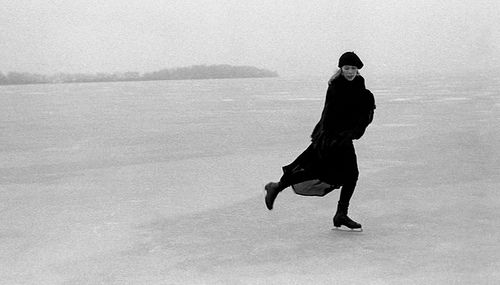
Photo of Joni Mitchell by Joel Bernstein (1976)
Happy December and Happy Holidays!
'Tis the season of joy, miracles, and giving, warm gatherings with family and friends, the lighting of candles.
In the coming days, bells will be ringing, we'll raise our voices in song, and around every corner, fa la la and ho ho ho. And yet I feel sorry for December. Not because it's the last month of the year, having waited patiently 344 days for its chance to shine. Not because its days are noticeably shorter, darker, and colder. No, I feel sorry for December because so much rests on it.
It's a month crammed with hectic activity, frantic over-spending, zealous over-eating. Suddenly we run around hither and yon, determined to make sure every single person we've ever known or loved is somehow acknowledged. We are pressured to socialize whether we want to or not, tip back that eggnog (glug glug), and by jingle by gum, be HAPPY.
Don't misunderstand. December doesn't really mind being Happy. It doesn't mind all the glitter and sparkle and lit-up faces of kids opening presents on Christmas morning. It certainly doesn't mind all the cookies, candy canes, or gingerbread men. No, December minds the remembering -- of childhood Christmases never to be relived, the missing -- of loved ones living far away, deployed overseas, or no longer with us, and the knowing -- that many are having hard times and will have a lean holiday, if at all. 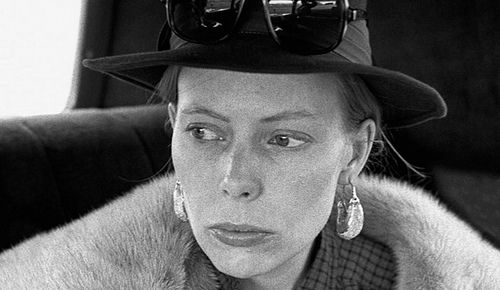
Godog84/flickr
Being the last month of the year, everything falls to December. Everything that could have, should have happened the past 11 months, but didn't. Missed chances, dashed hopes, youthful dreams losing more luster with each passing second. The across-the-board wake-up call when high expectations must meet reality is a lot for a single month to bear.
And yet the celebrations will continue, and we will go on, finding a singular beauty in the sadness, sporting badges of honor for having survived this long. We can skate away, if we like, escape to a place of emotional safety, selective remembering and quiet joy.
Joni Mitchell's "River" (here covered by Sarah McLachlan) has become a favorite non-traditional "Christmas song" for many people. Perhaps it is because unlike the traditional carols, this song about a romantic breakup addresses some of our reckonings and deep-seated longings. How much we yearn to see the light in our lives. How much it has hurt us trying to find it. How much we hope it will burn bright enough to get us through December.
♥ Special thanks to Cynthia Lord, who posted this video earlier this week.
♥ You can find Joni's original version of "River", which was included on her landmark album, Blue (1971), along with the complete lyrics here.
Blog: andrea joseph's sketchblog (Login to Add to MyJacketFlap)
JacketFlap tags: dog, drawing, moleskine, ink, portrait, Victorian, Etsy, tea, for sale, Regency, Joni Mitchell, in my head, silhouette, AJ, Add a tag
 James Alfred William George Galloway McAlistair ('Boston Jim')
James Alfred William George Galloway McAlistair ('Boston Jim')
Hailing from a small village in bonnie Scotland, James McAlistair, a determined and ambitious young political activist, set sail as a stowaway on a ship bound for the United States of America in 1773. On arriving at his destination he was discovered and thrown overboard, and found himself covered in tea.
After dragging himself ashore, and dusting himself down, McAlistair sneaked past the authorities and protesters and went into hiding. He lived on the streets of Boston for some weeks until he got back on his feet, found himself a place to stay and began work in the ship industry. He worked his way up from a tea boy to foreman. But McAlistair never forgot his roots, or the scenes and protests that met him on his arrival at the port. This, coupled with the way he saw other terriers being treated in the workplace, started him on his new calling.
'Boston Jim', as he was now known, travelled from town to town fighting for the rights of terriers throughout the sate of Massachusetts. He went on to become the founder of the Terriers Union that won the rights to a five day working week, two weeks holiday a year and a Bonio before bed time for terriers everywhere.
Original drawing for sale HERE.
Blog: Just One More Book Children's Book Podcast (Login to Add to MyJacketFlap)
JacketFlap tags: Co-operation/Collaboration, Intriguing, Review, Podcast, Community, Music, Ages 4-8, Detailed, Generosity, Gratitude, Respect, Picture book, Making a difference, Resilience, Appreciation, Fun, History, Celebration, Busy, Dance, Patience, Man, Poetry Friday, Non-Fiction, Self Publishing, festival, childrens-book, Review of the Week, Joni Mitchell, Woodstock, Abigail Yasgur, Barbara Mendes, Bethel, Joseph Lipner, Max Said "Yes" (The Woodstock Story), Max Yasgur, NY, Rhyming, Peace, Understanding/Tolerance, Add a tag
 Author: Abigail Yasgur & Joseph Lipner
Author: Abigail Yasgur & Joseph Lipner
Illustrator: Barbara Mendes (on JOMB)
Published: 2009 Change The Universe Press
ISBN: 9780615211442
Exuberant, edge-to-edge illustrations and simple rhyme salute a generous dairy farmer who took a chance on four kids, their dream and the prospect of peace.
You can watch Max Yasgur addressing the crowd at Woodstock, 1969, here.
August 15-17 2009 marks the 40th anniversary of Woodstock. How will you celebrate?
Other books mentioned:
More peace and tolerance on JOMB:
- And to Think That We Thought That We’d Never Be Friends
- Enemy Pie
- Silent Music (A Story of Baghdad)
- The Araboolies of Liberty Street
- Herb, The Vegetarian Dragon
- Interview with Uma Krishnaswami about her Bibliography of Peace
Pop over to Jama Rattigan’s Alphabet Soup for today’s full menu of poetry offerings. Poetry Fridays are brought to us by Kelly Herold of Big A, Little A.
We’d love to hear your thoughts on a favourite children’s book. Leave a voice message on our JOMB listener hotline, +1-206-350-6487, so we can include your audio in our show.
Blog: OUPblog (Login to Add to MyJacketFlap)
JacketFlap tags: A-Featured, A-Editor's Picks, cover, joni mitchell, both sides now, F#, judy collins, tqy_jeyuwcw, joni, mitchell, embed, pedal, tonal, tonic, Music, Add a tag
By Justin Hargett, Associate Publicist
Musicologists often reserve their scholarly studies for the likes of Bach and Stravinsky, but in his latest book, Lloyd Whitesell has comprehensively tackled the most avant-garde of pop songwriters, Joni Mitchell. Excerpted below, from his book The Music of Joni Mitchell, is an analysis of the harmonic palette of one her most famous songs, “Both Sides Now,” along with a live performance of the song from 1970.
“Both Sides Now” (Clouds) is one of Mitchell’s most celebrated songs, though her own dejected performance bears little resemblance to the Judy Collins cover version from 1967 which first made it a hit. The harmonies are almost pure major and tend toward the monochrome (I, IV, V). By now we can appreciate how incredibly limited such a palette is in the context of Mitchell’s style. She exploits redundancy for expressive purpose: the repetitive treading of the same harmonic paths captures an appropriately world-weary tone. Yet, with this monochromatic spectrum, Mitchell is careful to create textural variety and sculpt a precise lyrical shape with its own highs and lows.
The tonic pedal (F#) is rarely relinquished…Only twice does E# lead directly up to the tonic, in the vocal line at the end of phrases 1 and 3 (eg., “ice cream castles in the air”). These parallel moments stand out for several reasons. The voice, within a verse of generally drooping contours, rises a full octave span. At the same time, the guitar bursts past the F# which has capped its range until now. Not least, the vocal cadence with its leading tone and clear unconstrained dominant momentarily revokes the tyranny of the pedal. This elated gesture first corresponds with the high spirits at the outset of each verse of the poem. But then the something goes awry: the second half of each verse repeats the gesture of elation, but the words are no longer joyous. The poet now views her former joy with a jaded eye. The same music is used for both takes, the buoyant and the disillusioned…
Mitchell is treating tonality perversely in this song, using cadential movement as a downer and using a surfeit of tonal center as a symbol of tedium and disenchantment. To get the full effect of this virtuosic achievement, one need only compare Mitchell’s version to the Judy Collins cover, in which the astringent, landlocked tonal nuances are swept away in a sugary barrage of primary colors.
Blog: jama rattigan's alphabet soup (Login to Add to MyJacketFlap)
JacketFlap tags: poetry friday, joni mitchell, Add a tag
"I am a painter first, and a musician second." ~ Joni Mitchell
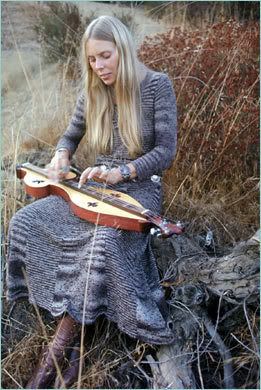
Last Friday, writer2b featured Suzanne Vega's song, "A Small Blue Thing."
I had never heard it before, but I loved the lyrics, so I used them as one of my writing prompts this week. Focussing on blue made me think of Joni Mitchell, whom I consider to be the finest female singer-songwriter of our time, and it made me want to see more of her art.
I was happy to find a collection of her work online. Here are two pieces I especially like, with a song to go with them. Joni's comment:
"This and the next drawing are of the kitchen table I had in Laurel Canyon, one done in the day and the other at night. It was a delicious room; the windows were big and the trees were quite a bit below so it was literally like living in a tree house. I've always been drawn to color; I had a bright blue salad bowl, a purple candlestick and very vivid hand-embroidered place mats. Everything was folk-artish as a matter of fact, so I guess my aesthetics were still quite related to folk music."
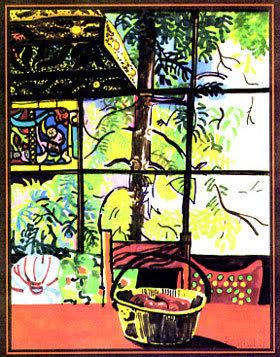
"Table Laurel Canyon I," Felt pen on paper, 1969
BANQUET
by Joni Mitchell
Come to the dinner gong
The table is laden high
Fat bellies and hungry little ones
Tuck your napkins in
And take your share
Some get the gravy
And some get the gristle
Some get the marrow bone
And some get nothing
Though there's plenty to spare
(Rest here.)
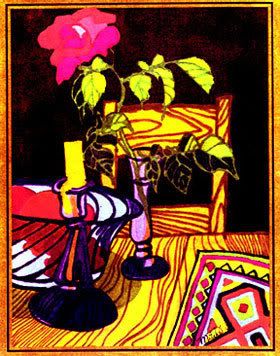
"Table Laurel Canyon II," Felt pen on paper, 1969
Don't worry. I haven't forgotten the wine. "A Case of You" is my favorite song from Blue (1971), supposedly written about Joni's affair with Leonard Cohen. Like the rest of the album, it is personal, poetic, confessional, real and true. It always slays me.
Oh I am a lonely painter
I live in a box of paints
I'm frightened by the devil
And I'm drawn to those ones that ain't afraid
I remember that time you told me you said
'Love is like touching souls'
Surely you touched mine
'Cause part of you pours out of me
In these lines from time to time
Oh, you're in my blood like holy wine
You taste so bitter and so sweet
Oh I could drink a case of you darling
And I would still be on my feet . . .
(Complete lyrics here, video here.)
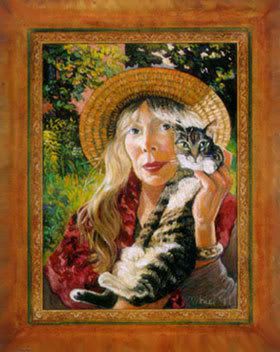
"Taming the Tiger," Oil on canvas, 1997
Joni's official website features song lyrics, a gallery of paintings, and a great timeline of her life and accomplishments.
For the full palette of today's poems, check in with Kelly Fineman at Writing and Ruminating.
To read any of the 2008 Poetry Friday posts you may have missed on this blog, click here.
Don something blue, and have a great weekend!!
Blog: andrea joseph's sketchblog (Login to Add to MyJacketFlap)
JacketFlap tags: Joni Mitchell, Add a tag
Blog: Happy Healthy Hip Parenting (Login to Add to MyJacketFlap)
JacketFlap tags: singing shijimi clams, this is the tree, tibili, sebastian's roller skates, while we were out, japan, taiwan, france, australia, england, fox, spain, guji guji, south korea, Add a tag
They've just created a blog which is a great place to learn more, add suggested titles and discover different ways to use the site, whether you're a parent, teacher, or librarian.
Kane/Miller is pleased to have a growing list of titles available at One More Story:
Written by Marie Léonard
Illustrated by Andée Prigent
From England

This is the Tree
Written by Miriam Moss
Illustrated by Adrienne Kennaway
From South Korea

While We Were Out
by Ho Baek Lee
From Taiwan

Guji Guji
by Chih-Yuan Chen
From France

The Costume Party
by Victoria Chess
From Australia

Fox
Written by Margaret Wild
Illustrated by Ron Brooks
From Spain

Sebastian's Roller Skates
Written by Joan de Déu Prats
Illustrated by Francesc Rovira
(Coming Soon)
From Japan

Singing Shijimi Clams
by Naomi Kojima









Love it Andrea! :-)
Cute drawing, Andrea. I shared your post with my friends, Charles and Andrea who Boston Terrier lovers. I'm glad to see that you're keeping busy :)
Thanks, chucks.
Salvador, I will get back to you. Promise! And, thanks for sharing.